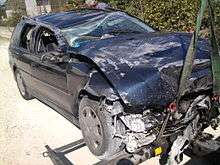Single-vehicle crash
A single-vehicle collision or single-vehicle accident is a type of road traffic collision in which only the one vehicle is involved. Included in this category are run-off-road collisions, collisions with fallen rocks or debris in the road, rollover crashes within the roadway, and collisions with animals.

The term single-vehicle collision is not generally used unless the rider or driver and passengers of the vehicle are the only ones injured. Crashes with only one motor-vehicle where bystanders (such as pedestrians or bicyclists) are injured are not usually referred to as "single-vehicle," although technically the term does apply.
The normal inference is that the cause is operator error (although operator error is also the cause of most crashes[1]). Common factors contributing to single-vehicle collisions include excessive speed, driver fatigue[2] and driving under the influence of alcohol or other drugs.[3] Environmental and roadway factors can also contribute to single-vehicle crashes. These include inclement weather, poor drainage, narrow lanes and shoulders, insufficient curve banking and sharp curves.[4] Some vehicles have unpredictable car handling characteristics or defects, which can increase the potential for a single-vehicle collision.
Suicide is also sometimes cited as a possible cause of single-vehicle collisions, although this is difficult to determine.[5][6]
References
- Walker Smith, Bryant. "Human Error as a Cause of Vehicle Crashes". Center for Internet and Society. Stanford Law School. Retrieved 28 May 2019.
- "The National Highway Traffic Safety Administration conservatively estimates that 100,000 police-reported crashes are the direct result of driver fatigue each year. This results in an estimated 1,550 deaths, 71,000 injuries, and $12.5 billion in monetary losses". drowsydriving.org. Retrieved 2012-07-26.
- Cohen, Sidney (1985). The substance abuse problems. 2. New York and Binghamton: Haworth Press. p. 112. ISBN 0-86656-368-7. Retrieved 14 Apr 2009.
- Neuman, Timothy (2003). NCHRP Report 500, Volume 6: A Guide for Addressing Run-Off-Road Collisions (PDF). Washington, D.C.: Transportation Research Board. ISBN 0-309-08760-0.
- Noel Baker (November 21, 2013). "10% of single vehicle crashes are 'suicide bids'". Irish Examiner. Retrieved March 28, 2014.
- Peck, Dennis L.; Warner, Kenneth (Summer 1995). "Accident or Suicide? Single-Vehicle Car Accidents and the Intent Hypothesis". Adolescence. Libra Publishers. 30 (118): 463–72. ISSN 0001-8449. Retrieved March 27, 2013.
